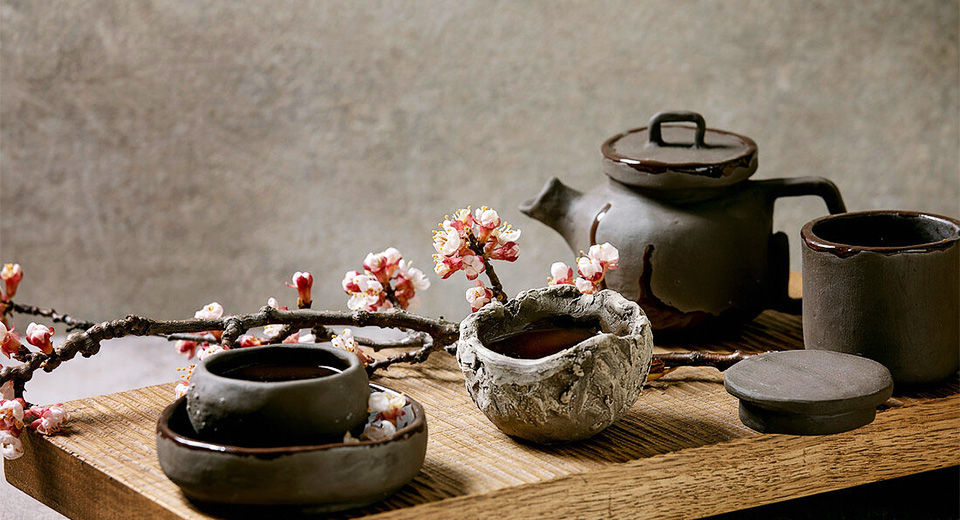Wabi-Sabi Meaning

"Wabi" started in Japan in the 15th century. It was linked to the tea ceremony and meant a peaceful, simple life away from city chaos to enjoy a calm, content life without feeling lonely or sad. It embodies the appreciation of beauty found in simple, humble aspects of life.
"Sabi," from the 8th century, used to mean loneliness. Later, around the 12th century, it became about finding beauty in old and worn things, even if they looked faded. It means that sometimes, the things we think are broken or imperfect can be beautiful if we look closely.
Together, these two concepts make a big way of thinking about life:
-
Accept things as they are.
-
Live in the present moment.
-
Appreciate the simple and temporary parts of life.
How did Wabi-Sabi Emerge?

Wabi-sabi philosophy comes from Zen Buddhism and is a story about Sen no Rikyū, a Zen monk learning the tea ceremony from Takeno Jōō. While trying to make things perfect, Rikyū accidentally made a mess in a garden by shaking a cherry blossom tree. This accident showed the beauty of imperfection.
This idea became important in Japanese culture, representing that life is not always perfect or permanent. It is linked to Satori, which means reaching enlightenment in Japan. Nowadays, wabi-sabi is a way of thinking that teaches us to be mindful and accept imperfections.
Kintsugi: The Art of Beautiful Repairs

When you embrace wabi-sabi, you see that nothing stays the same; unchanging things can change or get worn. An awesome example of wabi-sabi in art is Kintsugi.
It is when broken pottery gets fixed with lacquer mixed with gold dust. Instead of hiding the cracks, it makes them special, showing how beautiful they are because of the damage. This art celebrates the flaws instead of covering them up.
Kintsugi is also seen as a symbol of resilience by health professionals. It shows that after going through tough times and being hurt, one can heal and become more beautiful and stronger.
Principles of Wabi-sabi

-
Fukinsei- Asymmetry and Irregularit
The Fukinsei principle in wabi-sabi embraces asymmetry and irregularity in design and life. Instead of seeking perfect symmetry or uniformity, Fukinsei celebrates the uniqueness and unpredictability present in the world. It encourages appreciating the beauty of things that are not perfectly balanced or ordered, recognizing flaws and irregularities, and emphasizing that imperfection can be incredibly beautiful.
-
Kanso- Simplicity
Kanso in wabi-sabi means keeping things simple and tidy by removing what you don't need. It's about making things clear and calm. Kanso is about minimal stuff and wants things to be easy to understand. It's all about seeing beauty in simple things, removing what's extra, and letting the important parts shine. This idea believes that keeping things simple can make you feel peaceful and balanced in your life and surroundings.
-
Shibumi- Beauty in the Understated
The Shibumi principle in wabi-sabi cherishes the beauty of simplicity and understatement. It appreciates elegance that is not extravagant. Shibumi finds its charm in straightforwardness and subtlety, avoiding excessive decoration. It highlights a refined and understated beauty that derives from modesty and simplicity.
-
Shizen- Genuine Simplicity
The Shizen principle in wabi-sabi means appreciating and adopting naturalness and simplicity, urging us to enjoy the world's beauty without wanting to change or control it. Shizen focuses on finding beauty in natural, unpretentious things and free from artificiality or exaggeration. This principle teaches us to admire the authenticity and simplicity of nature and daily life, finding peace and joy in its inherent qualities.
-
Yugen- Subtle Grace
Yugen in wabi-sabi encompasses finding beauty in subtle and mysterious things and appreciating the hidden meaning behind something. Yugen values the feeling of wonder and the sense of enjoying the beauty of the unknown and leaving space for imagination and interpretation. This principle teaches us to appreciate life's quiet and mysterious aspects, finding beauty in what's not immediately clear or fully revealed.
-
Datsuzoku- Liberty
The Datsuzoku principle in wabi-sabi means being free from traditional rules and expectations, encouraging us to think and live unconstrainedly. It invites us to embrace creativity and individuality and find joy in the freedom of doing things in our own unique and unconventional way. By exploring new ideas and being adventurous, we can discover our path instead of following the crowd.
-
Seijaku- Tranquility
Seijaku, a concept in Wabi-Sabi, encompasses finding peace and tranquility, like embracing the quietness of everything around us. This principle values the beauty of silence, stillness, and peacefulness, allowing us to appreciate these moments in life. Seijaku serves as a gentle reminder to savor life's quiet and peaceful aspects, providing us with a sense of relaxation and inner calmness.
“I am perfectly imperfect” is wabi-sabi. This Japanese philosophy loves things that are imperfect, not shiny and new. It is seeing the world with kinder eyes, noticing the charm of worn or different things, and appreciating nature's flow, knowing everything changes and nothing lasts forever.
Wabi-sabi can be found in nature's irregularities, certain art pieces, cultural spaces like Japanese tea houses, and daily moments that embrace imperfections. You can even find homes with wabi-sabi interior designs that include natural wood and stone, use earthy and muted colors, and feature handmade or aged items. So, next time you see a broken mug or a weathered fence, remember wabi-sabi: it is not perfect but beautiful, just like life itself.










